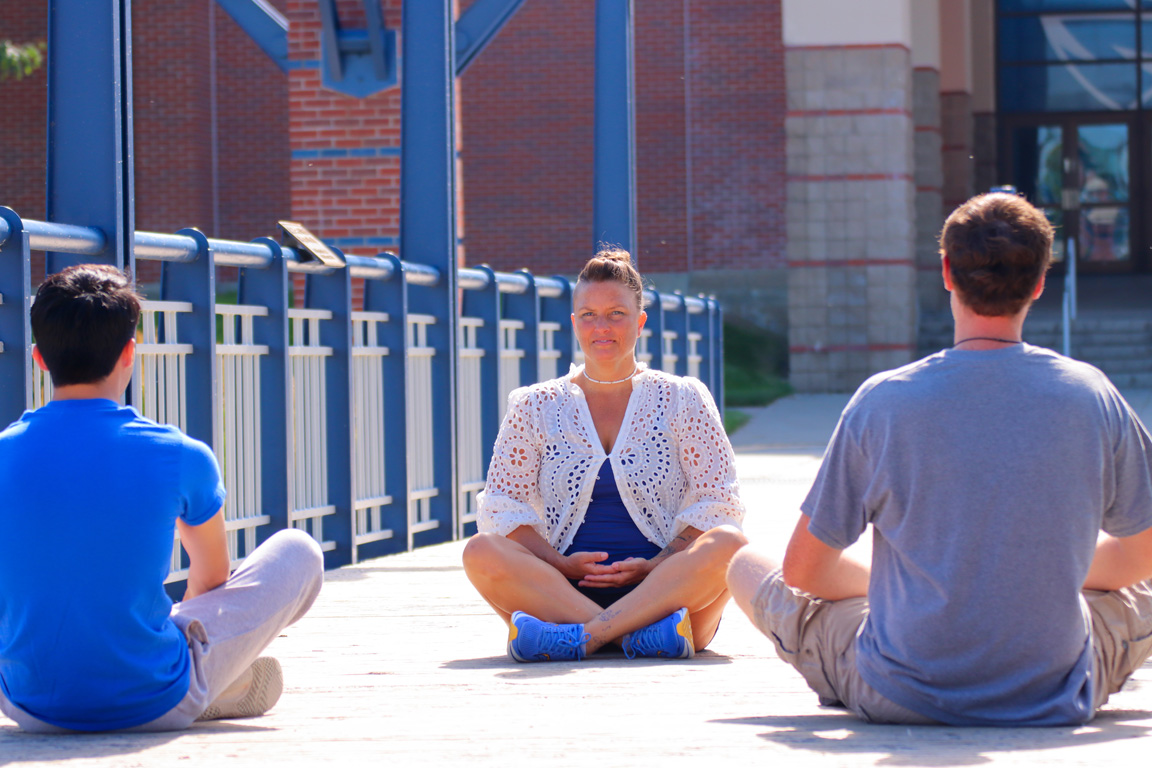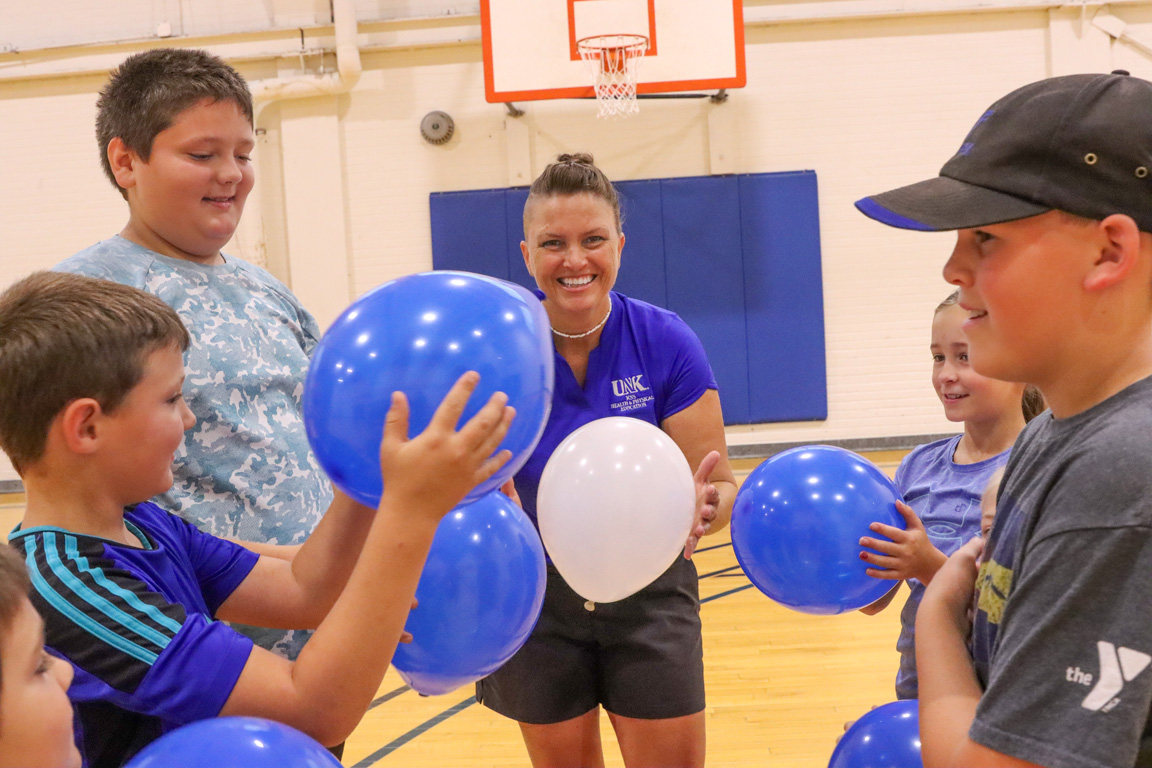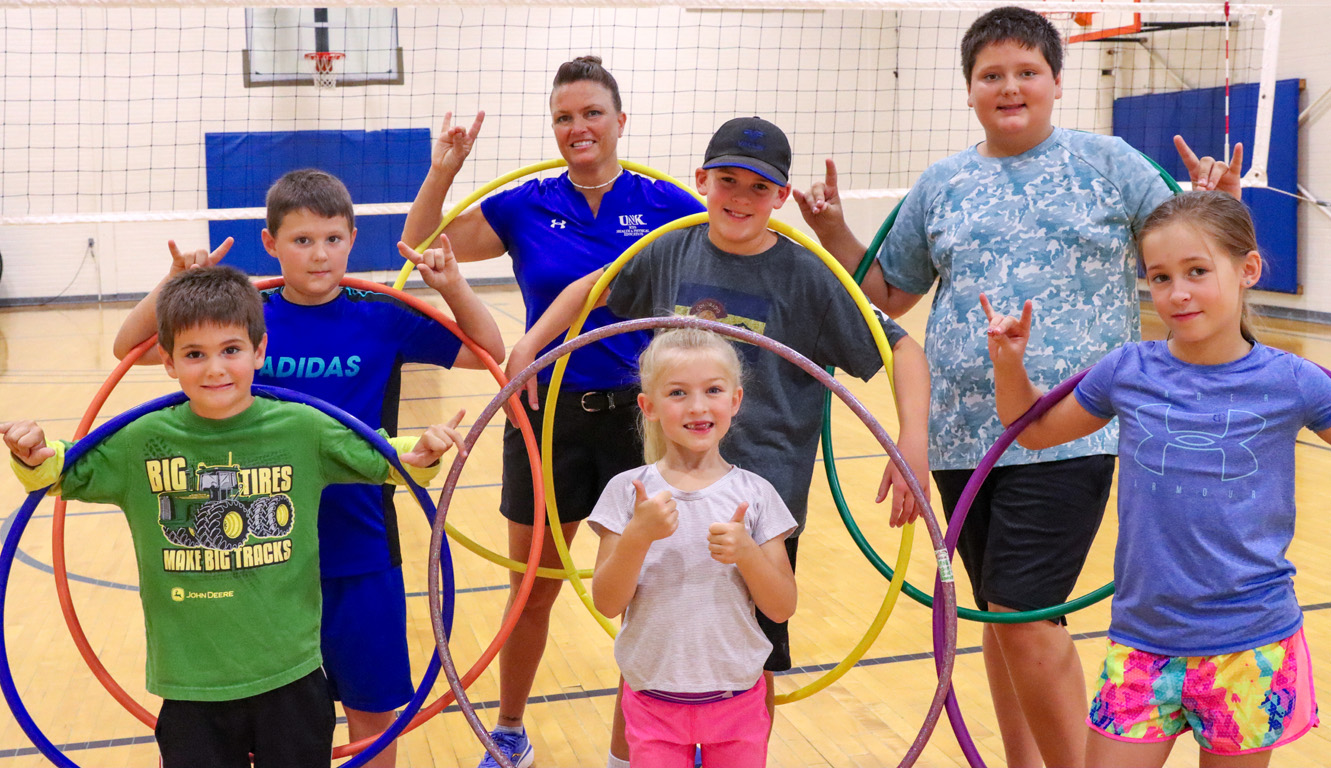
VIEW THE 2023 NEW FRONTIERS MAGAZINE FEATURING MULHEARN AND OTHER UNK FACULTY
By TIFFANY STOIBER
UNK Graduate Studies
KEARNEY – Shannon Mulhearn isn’t a surfer, but her business card said this for many years:
“‘You can’t stop the waves, but you can learn to surf.’ – Kabat Zinn”
She added this to her cards because it is a subtle nod to the practice of mindfulness, one of her research areas. It’s also a bit descriptive of her life and career: progressing from a first-generation college student to assistant professor of kinesiology and sport sciences, with a few changes in the tides along the way.
“I’ve tried to take challenges throughout my life and turn them into positives,” she explained. “All of those challenges were then met with some kind of response that helped me now connect with students.”
Mulhearn’s career started in a common spot, teaching in the K-12 setting and then moving from North Carolina to Arizona when she decided to pursue a master’s degree. Before earning her Ph.D., though, she also spent time as a licensed massage therapist and group facilitator at an addiction recovery center, teaching patients mindfulness meditation.
Mindfulness is, most basically, the practice of recognizing what’s happening at the moment, she says. For the rehab patients, these practices helped recognize triggers and then develop coping strategies to help combat the feelings that otherwise would make them turn to substances.
After working at the facility for a while, Mulhearn had a patient say to her, “It’s great that you’re teaching us this, but how do I deal with someone who doesn’t know how to mindfully communicate? Why do we wait until someone’s in rehab to teach them these things?”
Mulhearn realized there wasn’t a good reason to wait to teach these skills. If people could learn these skills as children in elementary school, it might help them avoid certain struggles, such as the rehab center she was working at, in the future.
It may have helped Mulhearn’s brother, Denny, who also battled substance abuse and ultimately succumbed to health issues related to his struggle.
Mulhearn says it was her brother’s death that sparked her drive to go back to school to finish her Ph.D. and hopefully start affecting change through research.

CHANGING PERCEPTIONS
Mulhearn found support and better direction for her research at Arizona State University, where she completed her doctoral program, from Pamela Hodges Kulinna and Hans van der Mars. Thanks to their mentorship, Mulhearn found she wanted to explore Comprehensive School Physical Activity Program (CSPAP) and physical education teacher effectiveness, while also continuing to pursue research into mindfulness and the school-to-prison pipeline.
At UNK, Mulhearn found even more support from Terese Sheridan, Megan Adkins and Erin Sweeney. Adkins and Sweeney have each been research partners, as well, sharing authorship with Mulhearn and others in recent papers.
One of Mulhearn’s recent focuses is on how CSPAP might be better integrated into K-12 schools.
Within the field, the benefits of CSPAP are already widely proven, Mulhearn explained. For example, students participating in some form of exercise before a test have been shown to increase their focus.
A CSPAP, then, looks at the student more holistically and breaks down barriers between physical education and classroom education, implementing more movement throughout the day, which in turn aids in student performance and classroom management.
“That type of research has already been done. The research shows if you increase students’ recess time, for example, that doesn’t negatively impact their grades,” Mulhearn said. “Everyone is worried if we give up time for reading, writing and math, that they’re going to see a decrease in test scores, but that doesn’t happen. There’s positive research that supports having a CSPAP in schools.”
If the research supports integrating more physical activity into the school day, then why do we see schools cutting recess and PE time?
Even if policy sets recommendations, Mulhearn explained, it’s still up to individual schools to follow those recommendations. That’s where her research comes in.
One of the most recent surveys Mulhearn helped conduct looked at what teachers say are barriers to implementing CSPAP at their school.
“As a university, we can look at that data to say, ‘They believe in it. They think it’s important. They have the tools for it. But they don’t have, for example, the support from their administration,’” Mulhearn said. “So, now instead of developing an intervention that wastes time on things that they already have, my intervention can just go where they see the problem.”
Some of these barriers are structural or based on resources, but the perception itself can also be an issue.
Mulhearn said she once heard that simply the perception of a problem is a problem.
“There can be, sometimes, a disconnect between university faculty, researchers and practicing teachers. If I come into a school as the university researcher, and I just spout off research and data telling them what they’re doing wrong, then it’s already going to be met with resistance,” she explained. “Without considering their perceptions, we are creating barriers instead of creating connections.”
While Mulhearn is positive that perceptions can change slowly but surely, an attitude she can back up by leaning on E.M. Rodger’s Diffusion of Innovation Theory, she has a lot of faith in the next generation of teachers UNK is educating and sending out into the classroom.
For example, many teaching degrees at UNK require a one-credit-hour movement course.
“A lot of teacher education programs don’t ever teach their classroom teachers how to integrate movement. UNK is at the forefront of that: supporting teachers to be able to lead movement in their classrooms. That’s one thing I really liked about UNK (when considering the offer to join the faculty). We all really work as a whole school to benefit kids cross-curricular instead of in our little boxes,” Mulhearn said.
Ultimately, for her, it’s all about helping children become the best they can be. That’s why she became a PE teacher in the first place, and it’s why she’s continuing to teach and conduct the research she is now.
“I wasn’t a PE teacher because I’m an athlete, but because I was interested in pursuing health and wellness. A PE teacher sees everyone in a school. We get this huge opportunity to help everybody, not just the athletes,” she said.

COPING SKILLS
While physical activity itself is beneficial for mental and physical health, Mulhearn stressed the importance of how sports education can also improve resilience and coping skills, which is where mindfulness skills come in.
She recently finished the paper “Planting Seeds of Mindfulness During Teacher Preparation,” which is being published in the Journal of Trauma Studies in Education.
“I think we assume those things are inherent, and we don’t point them out,” Mulhearn explained. “My intention with that paper was the idea that we can imbed these ideas or these concepts of mindfulness into our physical education curriculum, and as teachers we should be more intentional about pointing out those things.”
One example of this could be losing a game of Capture the Flag.
Children tend to take wins or losses in PE class very seriously, Mulhearn said. So, teachers can use that opportunity to help students recognize the feeling of disappointment and reflect, to ask themselves whether success at the game is truly important in the long run, and then help them move forward.
It’s a little bit like teaching kids how to “ride the waves” of wins and losses and keep moving forward in life, preparing them to tackle even the hardest oceans as adults.
That’s what Mulhearn has set her sights on for future research.
“My intention is to continue looking at a specific model for teaching resilience and coping through physical education,” she said. “I feel like we need more concrete direction and practices, so I want to look at potential not just in public schools, but looking at alternative school settings and the potential to break the school-to-prison pipeline through intentional physical education practices. Maybe teaching those coping mechanisms could break that cycle.”
SHANNON MULHEARN
Title: Assistant Professor, Kinesiology and Sport Sciences
College: Education
Education: Ph.D. in learning, literacies and technology with emphasis in healthy and active schools, Arizona State University, 2020; Master of Science in exercise and wellness, Arizona State University, 2008; Bachelor of Science in physical education, Appalachian State University, 1999.
Years at UNK: Three
Areas of Research/Specialization: Promotion of healthy and active schools; Role of mindfulness in building resilience; Bridging research and practice in K-12 physical education.
Courses Taught: Principles of Physical Education, Teaching Sport Skills & Non-Rhythmic Activities, Rhythmic Activities for Physical Education, Motor Development, Non-Rhythmic Physical Education, Integrating Movement & Dance, Elementary Physical Education Methods, Curriculum and Assessment in Physical Education, Practical Experience in Health & Physical Education, Senior Seminar in Health & Physical Education, Secondary Physical Education Methods, Curriculum Development in Physical Education, Elementary Physical Education Methods, Motor Development and Learning.
Recent Published Articles: “Classroom Teachers’ Perceived Barriers to Implementing Comprehensive School Physical Activity Programs Instrument Development,” Research Quarterly for Exercise & Sport, In Press. “Planting seeds of mindfulness during teacher preparation,” Journal of Trauma Studies in Education, In Press. “Fishing Downstream: Does CSPAP Promotion During PETE Transfer to Teaching Practice by K-12 Physical Educators?” Research Quarterly for Exercise & Sport, 2022.
PHOTOS BY ANA SALAZAR, UNK GRADUATE STUDIES
